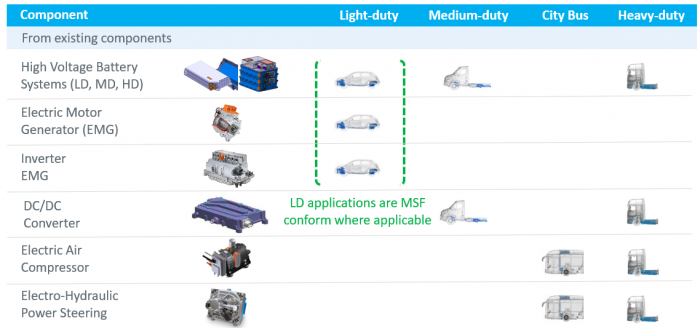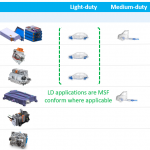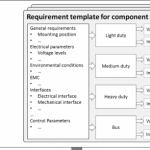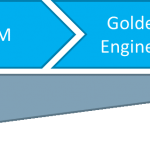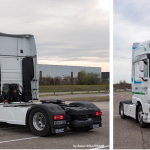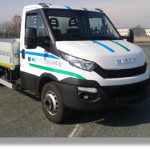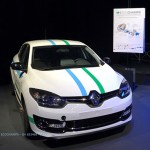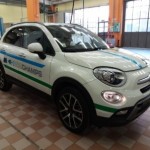Developments in summary (vehicles and components)
The vehicles
 Five demonstrator vehicles were developed in ECOCHAMPS to Technology Readiness Level 7. The TRL is a scale to estimate the maturity of a development (ranging from basic research to a system that is commercially ready): level 7 means a “system prototype demonstration in operational environment”.
Five demonstrator vehicles were developed in ECOCHAMPS to Technology Readiness Level 7. The TRL is a scale to estimate the maturity of a development (ranging from basic research to a system that is commercially ready): level 7 means a “system prototype demonstration in operational environment”.
The class B vehicle, based on a FIAT 500X, is designed as a plug-in hybrid with an electric range of 25 km. The demonstrator focuses on improving powertrain efficiency and offers additional functionality, such as pure electric and all-wheel drive. A plug-in powertrain is heavier and larger than a mild hybrid solution but is substantially more efficient and gives greater electric range.
The class C vehicle, based on a Renault Megane, is a 48 V hybrid demonstrator. The aim is to demonstrate a fuel economy comparable to a high voltage hybrid, whilst halving the powertrain costs by using lower voltages. A downsized, turbocharged and friction-optimised combustion engine is combined with a 48 V, 15 kW electric motor. The lightweight 48 V technology helps meet the powertrain weight and volume targets.
The medium duty vehicle is based on an IVECO Daily. The demonstrator focuses on improving powertrain efficiency and offers additional functionality (such as pure electric driving), whilst not reducing the flexibility of the vehicle. This flexibility is needed in the delivery business. A gearbox connects the high-speed electric motor to the prop-shaft and to the rear axle, giving the vehicle an electric driving range suitable for zero emission driving in city centres.
The city bus demonstrator is based on a MAN Lion bus. It focuses on powertrain efficiency and costs, in equal amounts. The main system components are modular, to have a basic electric bus that can easily be adapted to customer requirements. To explore the possibility of reducing costs, the demonstrator uses powertrain components and battery systems originally developed for passenger cars.
The heavy duty demonstrator is based on a DAF XF truck and has been fitted with a parallel hybrid electric powertrain to reduce CO2 emissions compared to the conventional vehicle. Similar to the bus, components from the high volume passenger car segment are used in the hybrid truck to reduce costs. This results in the voltage level of 400 V for the electrical architecture.
1.1 Components
Next to the vehicles, several components were developed in ECOCHAMPS. The goal was to take, where possible, advantage of synergies between passenger cars and heavy duty vehicles. Some of the components were developed starting from existing parts, others have been newly designed. In all cases, the components comply with the LV123 agreement (for light duty vehicles) or are based on the ECOCHAMPS Modular System and Standardisation Framework MSF. The hybrid components that have been developed in ECOCHAMPS are shown in Figure 2.
Modular System for Hybrid CV Components as Baseline for Standardisation
Context
Within the ECOCHAMPS project hybrid electric components with improved functionality, performance, costs and functional safety are developed and implemented in more efficient and cost optimised powertrains for light and heavy-duty vehicles.
While light duty (passenger car) components have the advantage of potentially high quantities, production numbers of heavy duty vehicles are comparably small. Within this context, establishing standards and norms especially for heavy and medium duty vehicles are a reasonable approach to increase the quantities across different OEMs and decrease the component prices in turn. Therefore, the ECOCHAMPS proposes a pre-standard framework, the Modular System and Standardization Framework (MSF), for drivetrain components and electrically driven auxiliaries.


